Engineering OKRs: Guide + 25 practical examples
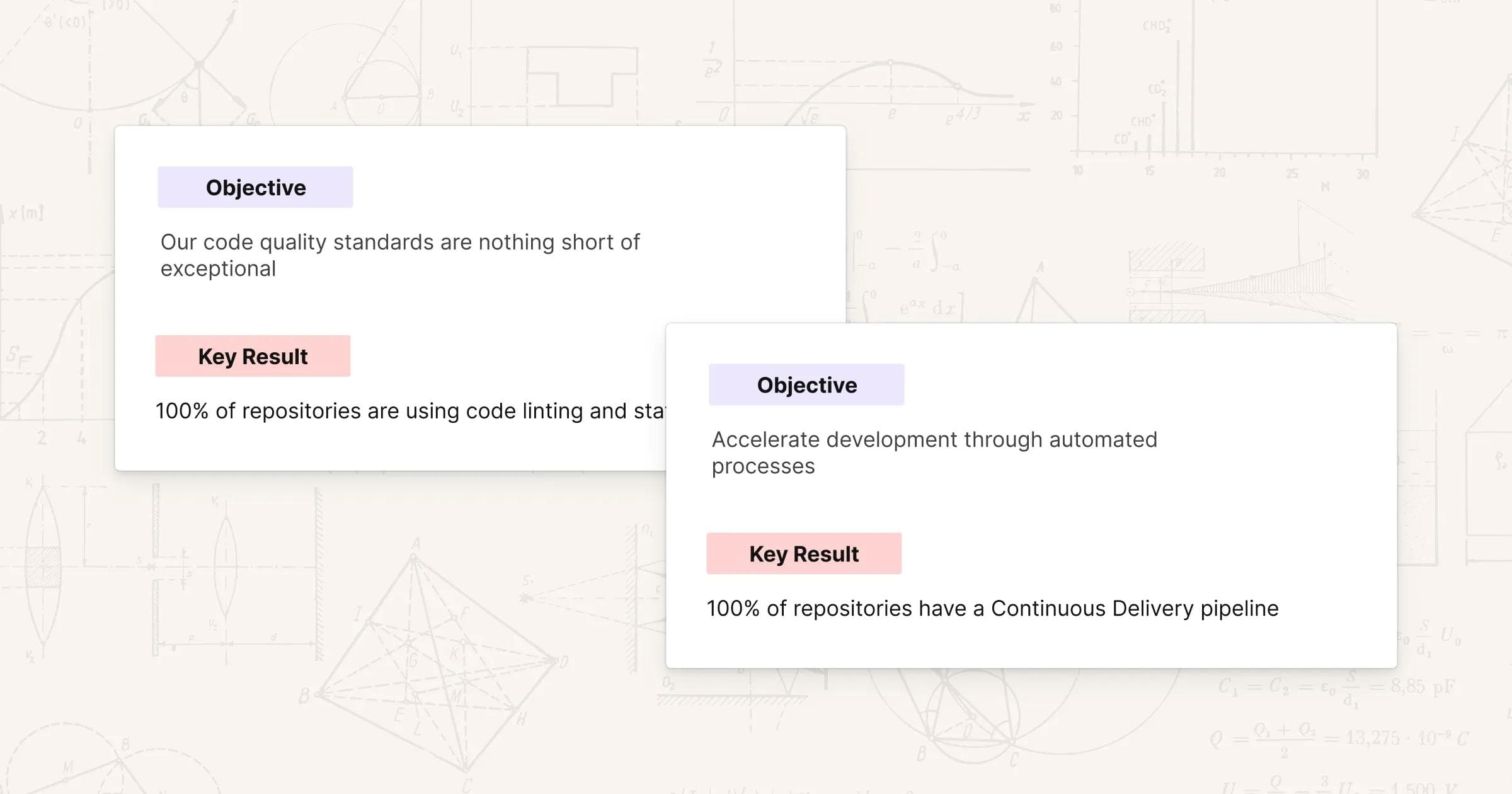
Developers are confronted with numerous technical problems every day. Ideally, they should solve all of these problems simultaneously to ensure that the product functions properly. Dedicated "engineering OKRs" can help engineering teams stay on top of things and focus on the essentials of product development.
In this article, we explain why OKRs for Engineering Teams are useful and how to write good Engineering OKRs – tips and concrete examples included.
What to expect:
- Why have OKRs for engineering teams?
- Engineering vs. product OKRs
- How to write good engineering OKRs
- 25 examples of engineering OKRs
- Conclusion: using OKRs to improve engineering work
Why have OKRs for engineering teams?
For engineering teams to be successful, they need to have a common understanding of success. The metrics chosen should be both relevant to the business and easy for them to understand.
OKRs can help engineering teams get clarity on what they want to achieve in the short and medium term. They are always developed collaboratively as a team and ensure that engineering goals are aligned with the business strategy and that everyone is pulling in the same direction.
💡 Reminder: OKR (short for "Objectives and Key Results") is an agile framework for formulating and implementing strategic goals in companies that consists of three core elements:
- Objectives: What do I want to achieve?
- Key Results: How do I know that the goal has been achieved?
- Initiatives: How do I achieve the objective?
As a rule, 2 to 4 Objectives are formulated per team and 2 to 4 result-oriented Key Results per Objective. The output is then mapped in initiatives (= concrete activities). More basic knowledge can be found in our OKR guide.
Hence, OKRs help people focus on what's important in terms of product development. They provide a short version of the overarching strategy for individual development teams and link short- and medium-term priorities to the overarching "why". This keeps development teams focused on the tasks that truly drive the business forward.
Additionally, our world is changing at breakneck speed. OKRs provide real-time data on changes in the environment. They also make progress and challenges visible. This keeps development teams agile and able to respond quickly to new conditions from one OKR cycle to the next.
Engineering vs. Product OKRs
In general, Engineering OKRs often resemble Product OKRs – i.e. OKRs for the entire cross-functional product team consisting of product managers, developers, designers, copywriters, and many more. However, there is a small but subtle difference: Engineering OKRs focus on the quality of the (technical) work, while Product OKRs focus on the added value for the customer. This is a bit simplified and generalized, but it shows the two sides of the coin.
Guideposts for engineering OKRs are questions such as:
- How efficient is our development process?
- How high is the quality of the releases?
- Is our development team able to work at its best?
So, overall, OKRs for development and product teams are closely related. In some cases, they also overlap. However, some development-specific matters are not mapped in product OKRs. These primarily include technical issues that do not affect the entire product team but are crucial to the successful realization of the product.
Solving technical challenges with OKRs
Development teams (especially in software development) often face complex technical challenges in their day-to-day work. Engineering OKRs can help overcome them by providing focus. They align all team members toward the same goals. When problems arise, OKRs provide clear direction for resolution. They also provide orientation for decisions and help prioritize technical improvements.
Development resources can then be focused and used more efficiently on the features and products that pay toward the company's strategic goals.
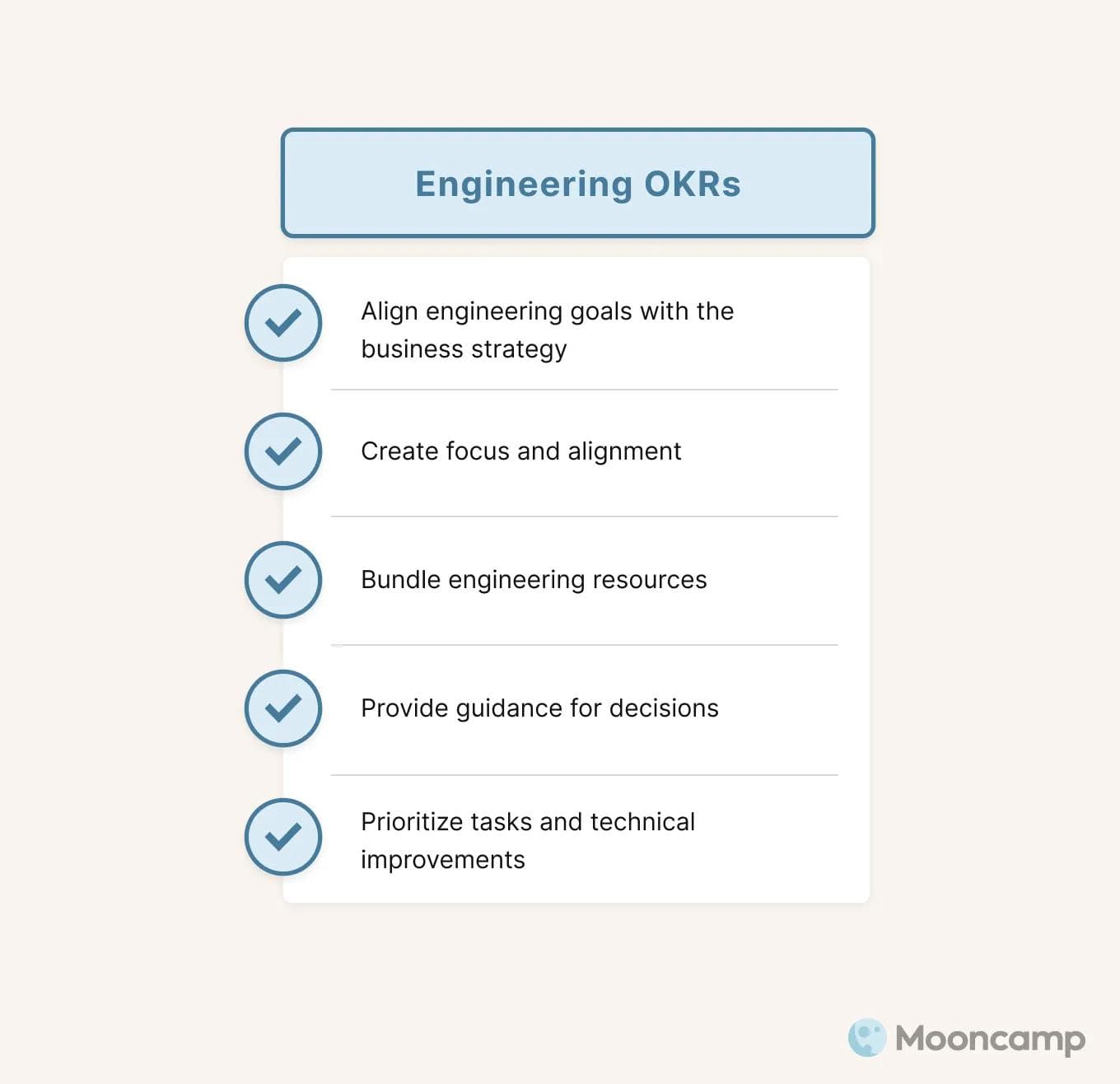
How to write good engineering OKRs
Setting OKRs for engineering teams can be difficult. OKRs need to align with business goals while being specific enough that everyone on the team knows what is expected of them. The key is to translate the rather output-oriented way of working in development into appropriate outcome-oriented OKRs. The emphasis here is on "oriented”. Engineering teams should indeed try to focus on outcomes per the OKR framework, but not for the sake of it. For some teams or topics, it may also make more sense to formulate output-oriented OKRs.
In general, good engineering OKRs can be formulated in four steps, which we will look at in a moment:
- Understanding the OKR method
- Collecting input
- Selecting focus areas
- Formulating OKRs
1. Understanding the OKR method
In the first step the basics of the framework should be clear. Those who want to create engineering OKRs should have internalized beforehand,
- what agile management and an agile mindset mean.
- how the OKR framework is generally structured and how Objectives, Key Results, and initiatives differ. Here it is worth taking a look at our OKR guide.
- what the difference between output vs. outcome is. If this is not clear, it can often lead to the success of OKRs being measured incorrectly and that work is not results-oriented (for more on this, see our article on OKR mistakes).
- What an OKR cycle is and how it works. This includes knowledge about the individual events that take place within a cycle - i.e., the OKR planning session, regular check-ins, the OKR Review, and the OKR Retrospective.
💡 Tip: An OKR cycle usually lasts three months. However, there is no fixed rule for this. Development teams should always choose the cycle length to fit individual needs and dependencies (e.g., fiscal year timeline or project schedules).
2. Gather input
OKRs for engineering teams should never be created simply out of the blue. Instead, they should be based on the question: What does success for our product look like at the end of the cycle from an engineering perspective? To give the best possible answer to this question through inspiring and results-oriented OKRs, certain input is necessary.
These include:
- Overarching company OKRs and/or OKRs from other departments and teams.
- Company vision and mission
- Product vision and strategy
- Existing OKR sets (if any)
- Product development roadmaps
- Insight into user feedback (e.g., known issues or solutions)
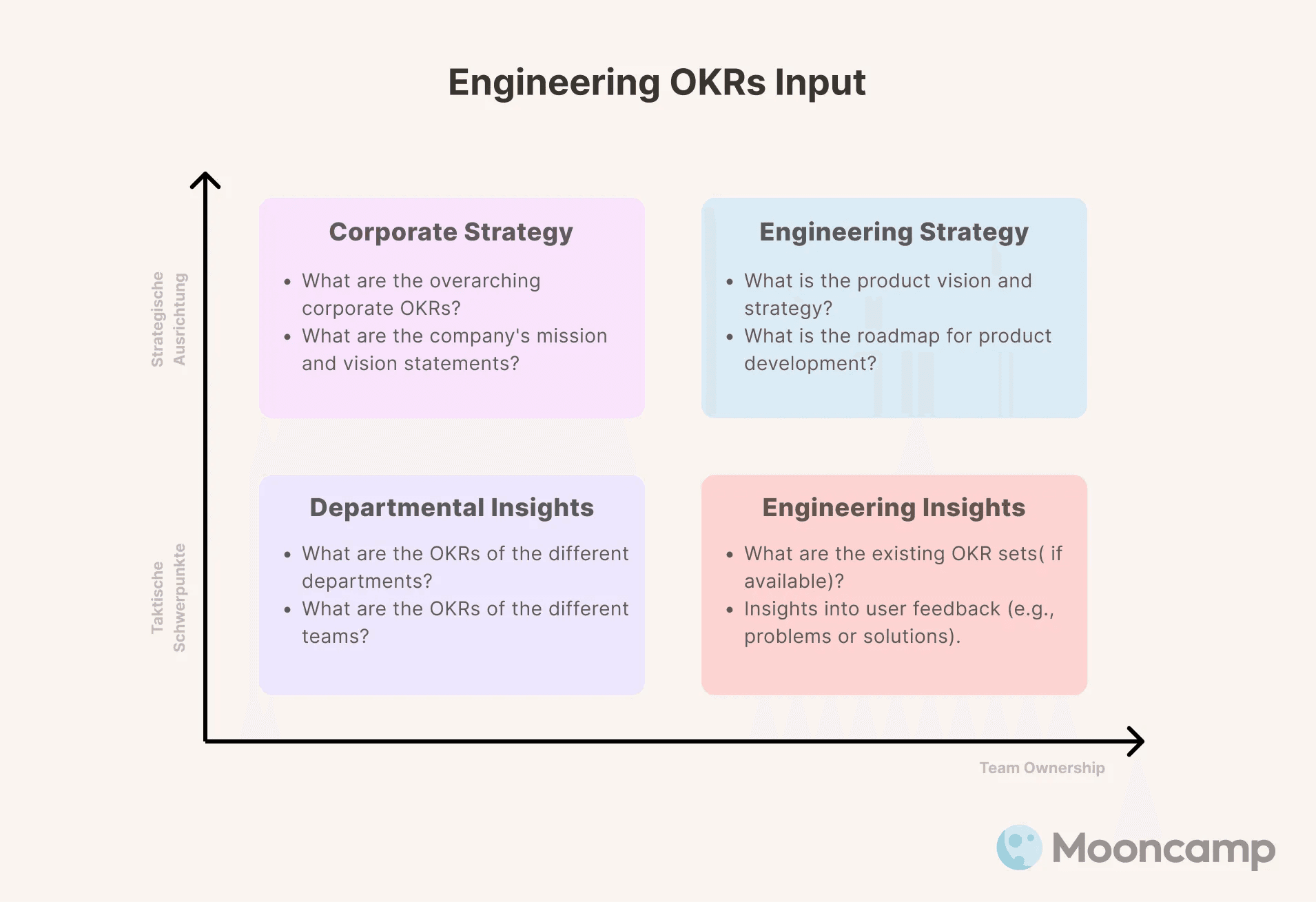
It is not always necessary to have all the information. The list is more intended to serve as an orientation as to what level of clarity should be present so that good OKRs can be formulated. If individual pieces of the puzzle are missing, the teams can still create OKRs for the current cycle and complete the information later. Finally, part of working with OKRs involves continuously developing the process itself.
3. Selecting focus areas
Are the basics clear and do you have all the necessary information? Then the next step is choosing the right subject to focus on. Particularly important for (software) engineers are:
- Functionality: Deliver new capabilities or develop new features.
- Performance: Ensure that a product or service works properly and is scalable.
- Usability: Improve existing features and make existing products or services more intuitive to enhance user experience.
- Reliability: Ensure that a product or service always works reliably and as expected.
- Security: Strengthen protection and use new measures to ensure that user data is safe and secure at all times.
- Dev Speed: Optimize the development cycle and release new features or products faster.
It is impossible to work on all topics at the same time. For this reason, engineering teams should always choose only two to three focus areas for the OKRs per cycle. To find out which topics are most important for the next cycle, it can be helpful to ask yourself the following questions:
- What are the strategic business goals we want to achieve? How can we contribute to them?
- Are there technical issues or security gaps that need to be urgently addressed?
- What customer needs or market opportunities should we consider or can we (more effectively) address?
- Are there new technologies or tools that we can leverage?
- Are there problems or bottlenecks in the development process that we should fix?
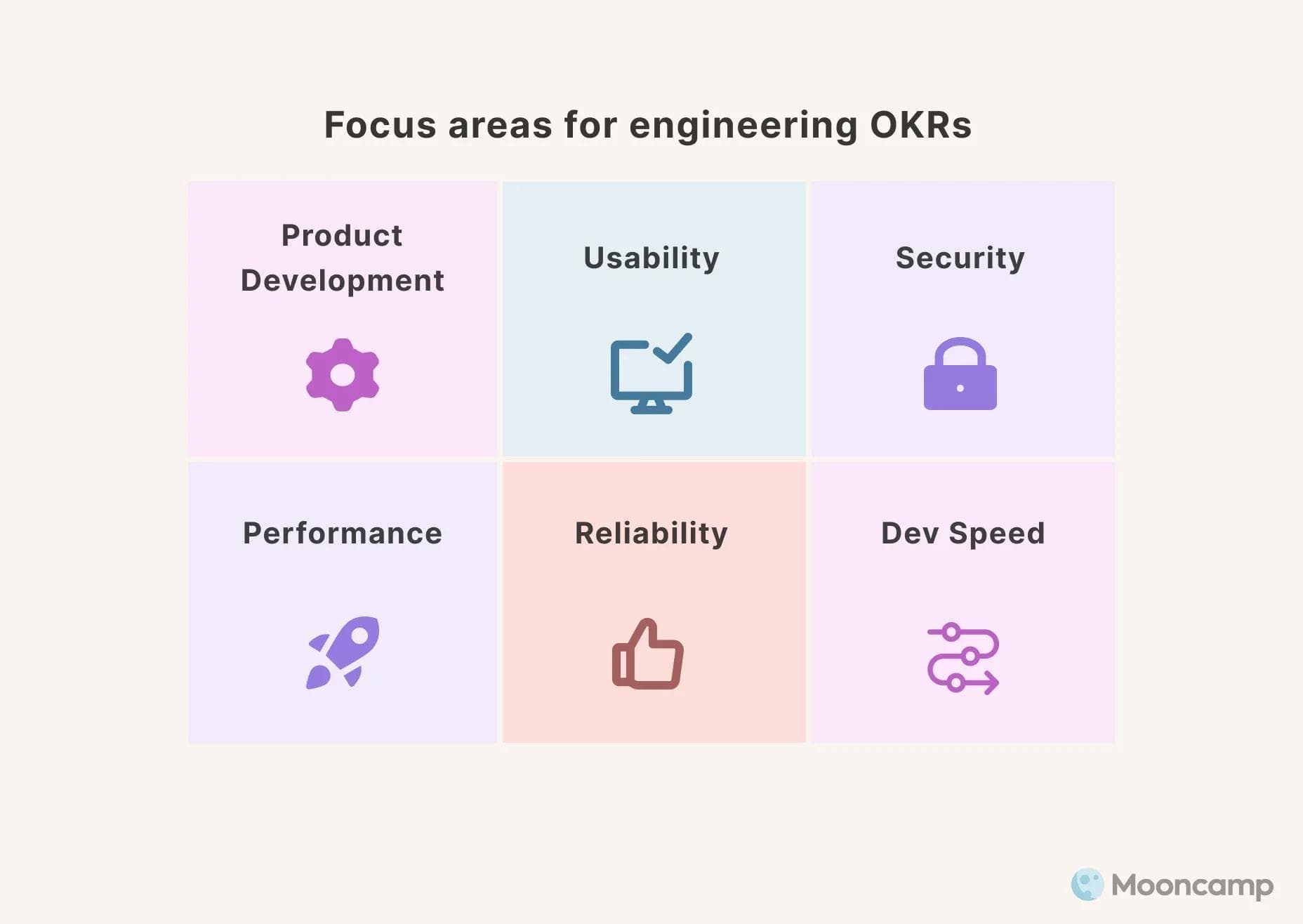
4. Formulating OKRs
Once the thematic priorities have been established, the next step is in formulating the OKRs. This is usually the most difficult part, where many teams fail. As a baseline, OKRs are governed by this rule:
We will [Objective], measured by [Key Results].
An Objective should always answer the question of what you want to achieve. Each Key Result then describes how one can recognize that the Objective has been achieved. Accordingly, Objectives should always be formulated in a qualitative, easily understandable, and inspiring way. Key Results should be measurable, result-oriented, and SMART.
We have summarized all criteria for good Objectives and Key Results as well as concrete formulation tips in our article "Formulating OKRs: Tips for really good Objectives and Key Results". The rules and tips from the article apply to all types of OKRs. For engineering teams (and OKR beginners), it may be better to first formulate so-called committed OKRs – meaning OKRs that are to be achieved 100 percent (more on this in our article about aspirational vs. committed OKRs).
Plus: Engineering teams should remember the difference between outcomes and outputs when formulating their OKRs. However, this does not mean that all engineering OKRs must necessarily be formulated as outcomes. OKRs also work with output-oriented Key Results. But then they have a different focus. Depending on what you want to achieve with the OKRs, it can sometimes make sense to focus on output-oriented Key Results at the beginning and only include outcomes later or only for certain topics.
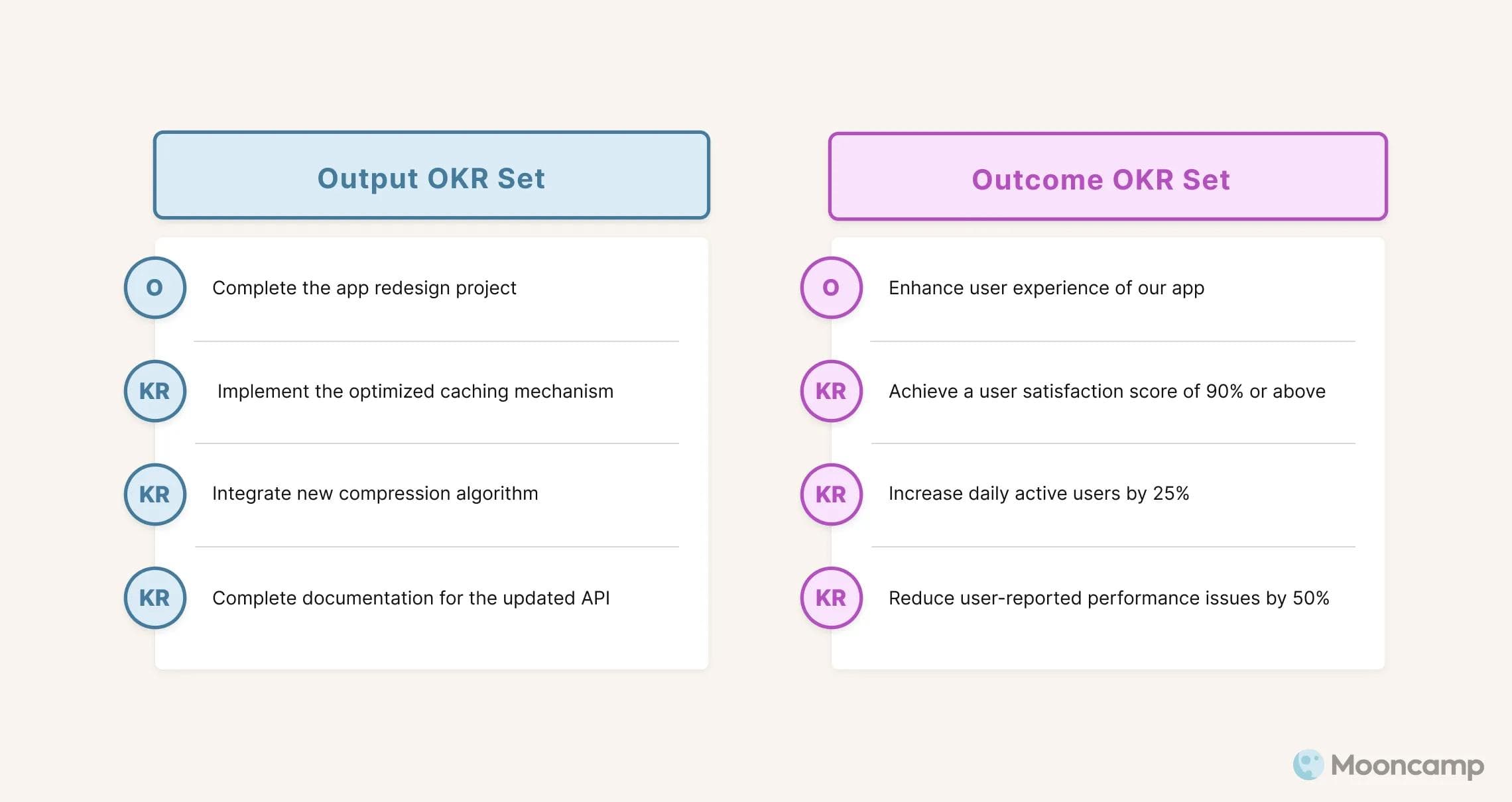
💡 Tip: In addition to finding the right wording, it can also be difficult for engineering teams to find correct Key Results metrics. To get started, we've compiled some suggestions:
- Development time
- Application response time
- Number of critical errors
- Usage rate for new features
- Market introduction time for new versions
25 Engineering OKR examples
To get you started, here are some examples of engineering OKRs.
💡 Note: We always recommend writing your OKRs. However, the examples here can be a good inspiration. There are even more OKR examples from other areas like Sales, Marketing, and Human Resources on our website.
⚙️ Functionality
📈 Performance
⛵️ Usability
🤝 Reliability
🔒 (Data) Security
💻 Dev Speed
Conclusion: Improve engineering work with OKRs
Overall, engineering OKRs help set clear goals for engineering teams that align with business strategy. This allows teams to focus on what's important and consider changes in the environment while improving the quality of their engineering work. Engineering OKRs always answer the question: what does success look like for our product at the end of the cycle from a development perspective? Both outcome- and output-oriented OKRs can be useful, depending on the needs and goals of the teams.
This is how Mooncamp can help
An OKR software like Mooncamp makes it easier for development teams to create OKRs and stay on top of things during product development:
- It provides transparency and alignment within the team or company.
- It enables better collaboration and serves as a central hub for communication.
- It is much easier to manage OKRs in OKR software than in Excel spreadsheets or misaligned tools.
- It ensures everyone keeps track of their OKRs through built-in check-ins and regular reminders.
- It provides insight into progress at any time and makes it easy to filter and analyze data.

